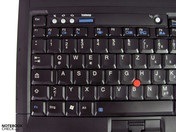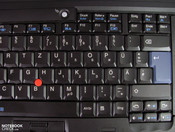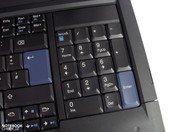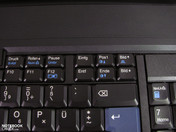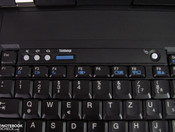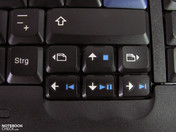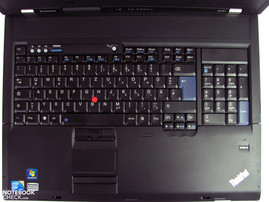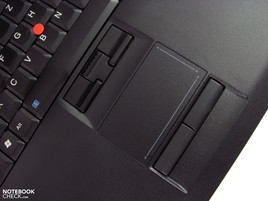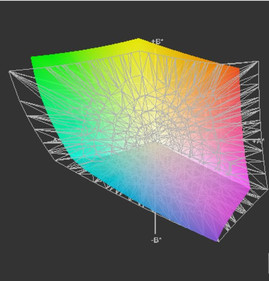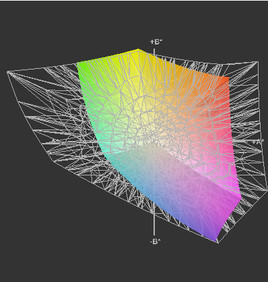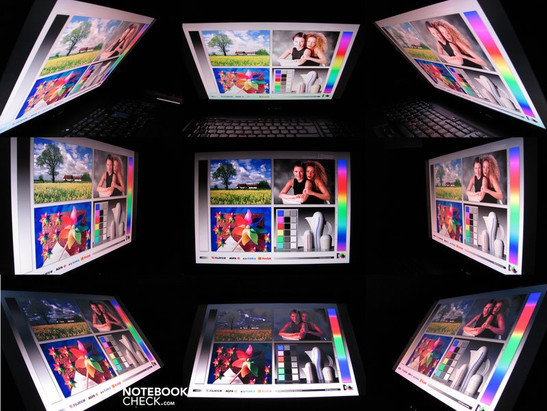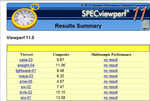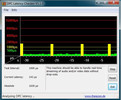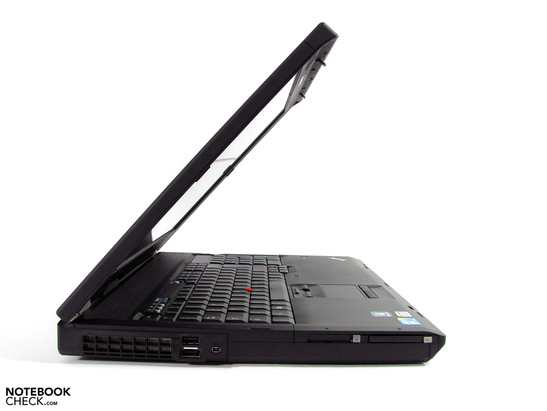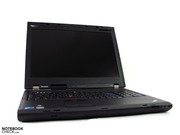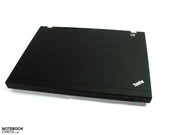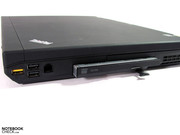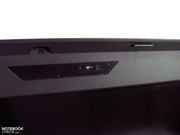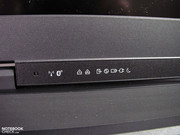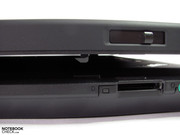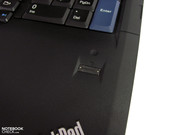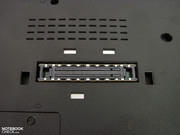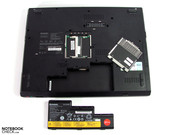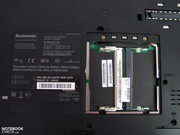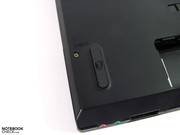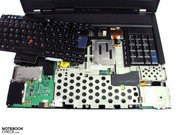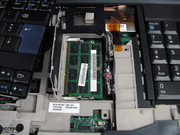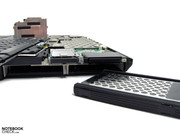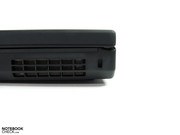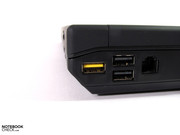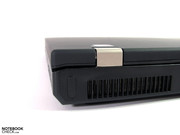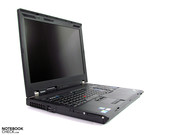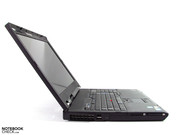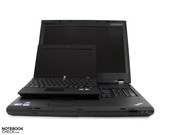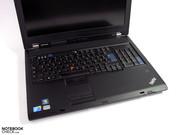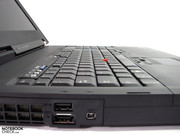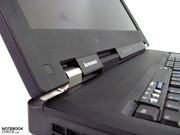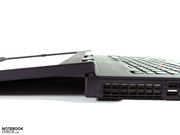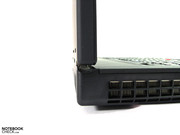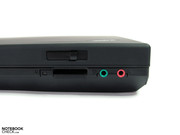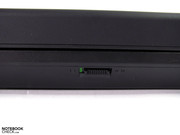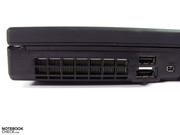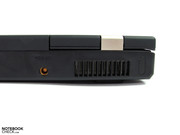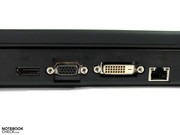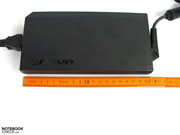Review Lenovo Thinkpad W701 Notebook

Since April of this year Lenovo has offered the refreshed W701 series, which replaces the well-known W700 series, for which we already carried out an extensive review. Whilst barely anything has changed on the laptop's case, a generation leap has been carried out on the inside of the device. After the Core 2 Duo processors, Intel's current Core-i technology comes into play, in the special quad-core chip from Intel's Clarksfield range.
For this reason, well-known qualities of the platform meet new, capable hardware. Among the available processors the Intel i7-920XM CPU is available, one of the highest-performing CPUs available. Also when it comes to graphics Lenovo splashes out and offers two equally capable candidates for professional use in the form of Nvidia's Quadro FX 2800M and respectively FX 3800M.
The workaholic can therefore configure the system for the whole spectrum of special applications. The price also shows appropriate scope: it starts at just over 2000 Euro, whilst the highest price of the models on offer in Germany is in places significantly more than 5000 Euro. Private users will thus capture a minutely small fraction of sales.
Case
Visually, nothing much at all has changed on the case. Before us is a like-for-like clone of the Thinkpad W700. For this reason you can refer to our corresponding review. Nevertheless here's a short summary: the Thinkpad W701 treats itself to a respectable amount of space on the desk at 41x31 cm. If you want to use the device on the go, you'll have to account for around 5 kilos (including power supply) in a bag that's hopefully big enough. A typical factor of the Thinkpad range is the lack of visual emphasis and is completely drenched in black with matte surfaces throughout.
Contrary to the T-series or the smaller Thinkpad W510, on the W701 you're predominantly confronted with plastic on the base unit as the effective surface material. Only the display lid is finished in a rubberised magnesium surface. The stability of the device is OK on the whole, even if a slight deformation of the case can be observed here and there under selective pressure.
Connectivity
We almost missed a change in the offered ports: on the left-hand side the position of the two offered USB ports has been interchanged with the FireWire interface. Thus all performance interfaces, including USB 3.0 and eSATA, are found in the rear of the left side and all USB 2.0 connections are far to the front on the right of the case.
The eSATA port becomes powered eSATA in combination with USB 2.0 and so can also assume the power supply of external hard disks with a powered eSATA connection. The maximum transfer rate was measured at 96.1 MB/s and is thus a good value for eSATA. USB 3.0 meanwhile lags behind the possibilities at 88.1 MB/s; on the HP 8540w, for example, we measured more than 100 MB/s. FireWire 400 in the 4-pin variant known to Windows computers isn't capable of providing power, yet at 35.9 MB/s it is around 8 MB/s faster than USB 2.0. Lenovo offers three USB 2.0 ports towards the front on the right of the case, where again powered USB 2.0 can charge external devices when powered off.
You can retrofit more interfaces or other extensions via the present ExpressCard/34 slot, alongside which there's a rarely-found slot for Compact Flash cards. According to Lenovo there are also variants with ExpressCard/54 slots, SmartCard- and PC Card-slots in differing combinations. The frontal card reader didn't like our OCZ SD card, yet we still reached 19 MB/s with a SanDisk Extreme III SD-HC. Further upgrade possibilities are offered in the second hard disk slot, the Ultrabay equipped with an optical drive, and the docking port on the underside.
In terms of communications technology alongside Gigabit-LAN, Bluetooth and WLAN 802.11n you also have the possibility to use an analogue V.92 modem. There's no UMTS-module in our test device and it also isn't currently offered.
As for docking station there's the Lenovo Thinkpad W700 Mini Dock 2.0 (57Y4345, around 190 Euro) or a USB port replicator with a digital monitor output (45K1611, around 130 Euro). Otherwise you'll find many additional accessories from well-assorted merchants or the less assorted manufacturer's page like mice, keyboards, bags, hard disks and batteries, all of which can be better compared before purchase with offers from third parties.
When it comes to software the workstation offers no unusual extras. The well-known Lenovo assistants (system tools) attend to your chores respectably, and depending on what you need to do and user taste, they are only rarely uninstalled, unlike the software provided by many competitors. Windows 7 Professional 64 bit is used as the operating system and covers the demands of the target groups well.
Input Devices
Keyboard
The W701's keyboard can draw on unlimited resources due to the case size and provides generously-dimensioned input including a separate number pad. Room has been found for the one or other special key, which is often otherwise integrated via FN combinations, as well as sufficiently sized arrow keys. Thinkpad newcomers will, however, have to get used to the Lenovo layout a little, as not all keys are to be found where you would normally expect them to be. "Esc" is far above, almost positioned off the keyboard, whilst "Ctrl" and "FN" are, as always, interchanged. "Del", "Pg Up" etc. are collected in a block above the F-keys. When you're looking for a rarely used function, you also have the impression of being struck dead by the amplitude of the keys on offer. The inscription isn't quite as high-contrast as the competition, yet in poor surrounding light you can fall back on the Thinklight keyboard illumination.
The fact that the keyboard isn't really firmly set is somewhat disappointing, whereby the left border and the area of the return key can be visibly depressed. A slight bounciness whilst typing is observed above all in the left area of the keyboard. The medium-length stroke has a good pressure point and makes an otherwise good impression, whilst the stroke noise is in the spectrum of many competing models. The larger space bar, enter key, right shift and backspace sound somewhat louder and are almost rickety. This isn't what we are used to when it comes to Thinkpad keyboards and makes a disappointing impression, especially considering the test model's price for the premium Thinkpads starting at 2200 Euro.
Touchpad/ Trackpoint
Considering the dimensions of the laptop, the touchpad is rather small and, because of the high screen resolution, often needs two swipes of the finger on the way to the target. Otherwise, the operability is very successful. With great gliding qualities, a good feel and good input recognition, the touchpad is suitable for a long while as a mouse replacement. Its keys are effortless and quiet and perform commands just as well.
The model at hand can fully confirm the good reputation that the trackpoints possess. The very precise navigation with lightly operated keys makes a very good alternative to the otherwise standard touchpad, after some getting used to.
Display
Whilst the Thinkpad W700 was only equipped with a "conventional" display, in our test model a display with RGB LEDs came into play. The matte 17" FHD panel has a standardised, high resolution of 1920x1200 pixels (WUXGA) and thus offers a dot density of 133 dpi. Only current workstations in the 15.6" format offer an even finer image with a resolution of 1920x1080 pixels (141 dpi). The relationship between display size, desktop area and image size is optimal for many users of professional software and provides the necessary overview of the screen's contents. If symbols, icons and tools seem too small for you, you can, in most cases, adjust these to your taste in the control panel. The factory-set default is configured to 125% as standard.
| |||||||||||||||||||||||||
Brightness Distribution: 82 %
Center on Battery: 268 cd/m²
Contrast: 687:1 (Black: 0.39 cd/m²)
The brightness of the display can also be adjusted to suit the respective requirements of the user. It can be set at 15 levels from 25 cd/m² up to 268 cd/m². 100 cd/m² is already reached by our test model at level 11 and at level 12 the background illumination provides 115 cd/m², which is sufficient for many indoor rooms. At maximum brightness we obtained nine measurements from 220 cd/m² to the maximum value already mentioned - 268 cd/m². This yields an illumination of 82%, which is a respectable value considering the display size and above all turns out much better in comparison to its predecessor, the Thinkpad W700 (63%). Brightness differences are consequently only evident when scrutinizing monochromatic backgrounds and should not be distracting in many cases.
Also the large Thinkpad Workstation isn't really targeted at mobile use; with the brightness undiminished running from the battery the bright display allows a very good level of usage outdoors. Not only the anti-glare display but also the good contrast value contributes its part in this.
Finally we obtained a contrast ratio of 687:1 from a measured black value of 0.39 cd/m² and the maximum brightness. The attractive contrast ratio provides first and foremost good-looking black, without drifting off into the otherwise standard grey. It doesn't turn out so great for white, as, depending on the viewing angle, we would sometimes see it creep into the red- and green-hues. This occurs particularly strongly if you don't calibrate the display or you use it without an appropriate colour profile.
The colourfulness of the RGB-LED displays is staggering. Even the large Adobe RGB colour spectrum, which admittedly can't be completely covered in the green-yellow range, is in other areas greatly outclassed. After a short 'wow effect' these cool tones admittedly call for adjustment and at best with a colorimeter, in order to calibrate the display. Here you can specify particular colour spectra (e.g. sRGB, NTSC or Adobe RGB) or your own requirements. As a result you might forfeit one area of the colour spectrum, yet you also get a reasonable set-up without exaggeration.
The viewing angles of the panel are good all round and allow you to look at the screen from extreme positions. As usual the vertical range is weaker than the horizontal range, but can be considered good, as far as the recognisability of the image contents are concerned. The same is, however, not true of the colour stability. Here we have to note a green/yellow tint from above and a red tint from below from small deviations to the seating position. Therefore colour-proof work is barely imaginable even with a calibrated display. For many other tasks this is, however, less serious and only a small blemish of the other very good panel.
Also available is a variant of the W701 with a WXGA+ display (1440x900 pixels) yet without knowing the other qualities it's less recommendable because of the low resolution and the very unattractive pricing (with the test device an otherwise comparable configuration is currently just under 3000 Euro).
Performance
Our Lenovo Thinkpad W701 variant at hand has one of the first available Core i7 CPUs, the quad-core Core i7-720QM. This has a basic clock speed of 1.6 GHz and can overclock itself in single-thread applications up to 2.8 GHz with Turbo Boost. Further features are the 1 MB L2 cache, 6 MB L3 cache, hyper-threading (each physical core is allocated a virtual core and so allows simultaneous computation on 8 threads) and a front-side bus of 2500 Mhz. The CPU is even made in the 45 nm process, yet with a TDP of 45 Watt it belongs to the more energy-hungry notebook range of processors.
The CPU benchmarks lie in the usual region and the CPU computes wPrime1024 in 502s, superPi 32m in 902s and reaches 3552 points in Cinebench Rendering Single and 9328 points on Cinebench Rendering Multi. Itunes converts MP3 to AAC at a rate of 29.2x. In this single-core task a high clock speed is in demand, whereby the Core i7-720QM falls behind compared to an i7-620M CPU (dual-core) that converts the same at a rate of 38x.
Intel's QM57 chip-set provides the basis for the system, which is mainly used in professional systems and is consequently well placed in the W701. Here up to 16 GB DDR3 RAM in four slots can be used. Our test model is equipped with one 2GB module whose slot is found underneath the keyboard, alongside one other. How to properly access these and many other components is extensively depicted and illustrated on the Lenovo support page. Also the order of the RAM equipment isn't inconsequential, and is also appropriately explained. The RAM slots on the underside are more easily reached, which as usual are accessible via a cover.
Crucial selling points for most workstations are the respective Quadro (Nvidia) and FireGL (ATI) graphics chips. These use an adjusted BIOS and require special drivers that are optimised for professional use. A list of ISV-certified software for the W701 workstation with the respective drivers recommended can be found here.
In addition Nvidia offers special performance drivers for AutoCAD and 3dsmax that should provide a further speed boost. In our Thinkpad W701 there's Nvidia's Quadro FX2800M, which has 1 GB of DDR3 graphics memory. It has a core speed of up to 600Mhz, 1500 Mhz shader and 1013 Mhz memory. The clock speeds can be underclocked according to demands and thus reduce power consumption.
In the test device we found a graphics driver version of 8.16.11.8898 from March 2010. By now version 8.17.1258.96 is available from Nvidia's site from 09.07.2010. We carried out all tests with the preinstalled driver, as this is the only one found on the Lenovo support site. With the updated driver we saw the performance differences in the professional applications, as is usual for workstations, with the help of SPECviewperf 11. And did this do a lot. Whilst the FX2800M can barely break away from the FX880M in a Fujitsu Celsius H700 with the preinstalled driver, it succeeds in doing so a lot better with the updated driver. In Catia, Lightwave, and Solidworks, the increases are in fact enormous.
With SPECviewperf 10, through which we have provided more comparison values, the FX2800M can, depending on application, hold its ground well, yet on Solidworks and Maya it by far didn't reach the performance that we measured on the Thinkpad W500 with ATI's FireGL. Also it can't really set itself apart from the competition within its own brand and the additionally nominally weaker Quadro FX880M. Here the driver update incidentally achieved no performance increase.
On 3D Mark Vantage, at 5787 points, better results are achieved than the HD5850 in the Acer Aspire 8943G, yet it again lies just under 400 points behind a Nvidia Geforce GTX280 in the Deviltech 9700 DTX. The FX880M graphics chips in the Fujitsu Celsius H700 and also in the HP Elitebook 8540w are clearly beaten here. Both reach around 2600 points.
In the OpenGL Shading of the Cinebench R10 the Quadro FX2800M records 4662 points. Here the results are on the same level as the FX880M from the H700 and the 8540w, which only shows marginal differences. The driver update didn't make any performance increase known.
When it comes to video conversion there are basically two options. Either you let the task be carried out by the CPU, which has a high system load as a consequence, or you give the task over to the graphics processor, whilst consequently keeps the processor load low. The advantage: many tasks can be carried out, without any performance losses.
With Cyberlink's Mediashow Espresso you indeed have the chance to make both choices, yet until now only older Nvidia GPUs are supported. The Quadro FX2800M can't be found in the list. We couldn't ascertain any performance difference with or without CUDA, probably because of the lack of support. Without CUDA the GPU underclocks itself shortly after conversion begins, whilst with CUDA the GPU runs at its full clock speed until the end. The CPU runs at 1.7 GHz und short increases in clock speed occur in both cases. The result is always the same, however, at 74s.
In Badaboom the rating turns out easier, as this program only works with CUDA and is appropriately optimised. Here we reach the best result of this series of tests with 112 fps. Elemental's converter is thus the clear favourite as far as conversion with Nvidia graphics cards is concerned.
With the tool DPC Latency Checker we tested the possible latency problems of the interfaces, through which synchronisation problems can appear when connecting external hardware, in particular in the field of audio and video. Here the Thinkpad appears really inconspicuously, so no limitations are assumed.
| PCMark Vantage Result | 5600 points | |
Help | ||
We tested the application performance amongst other things with PC Mark Vantage and we can confirm the very good impression we got from the result of 5600 points. Word-processing, photo editing, databases and other communications- and office-tasks are effortlessly overcome, yet only sometimes suffer from the low amount of RAM. A prompt upgrade to 4 GB is thus advisable for the test model in any case, in order to remove the stumbling block.
| 3DMark 2001SE Standard | 34844 points | |
| 3DMark 03 Standard | 33900 points | |
| 3DMark 05 Standard | 16310 points | |
| 3DMark 06 Standard Score | 11162 points | |
| 3DMark Vantage P Result | 5787 points | |
Help | ||
As for hard disk in the Lenovo Thinkpad W701 there's a 320 GB disk from Seagate (ST9320423AS) that runs at 7200 RPM and has 16 MB cache. In the HD Tune benchmark it reaches a maximum transfer rate of 93.7 MB/s and an average of 73.1 MB/s. For this device range these are standard values that, when compared to other conventional hard disks, barely evoke any performance losses.
More hard disk space or more speed can be reached by installing another hard disk or an SSD in the neighbouring slot. You can merge these via RAID 0 (striped) or RAID 1 (mirror) with the already occupied slot. An additional SSD as a system drive is the most obvious solution, letting you reach a high performance increase whilst retaining the present disk space. For even more disk space you can replace the optical drive with another hard disk with the Ultrabay adapter. Therefore you have many possibilities to upgrade the workstation to your desire whilst bringing about a performance increase.
Gaming Verdict
The games that we tested mean the Nvidia Quadro FX2800M is classified on the level of an Nvidia GTX260 or an ATI HD 4850. The already good benchmark results of 3D Marks are not only assumed in the gaming tests but are also suitably confirmed. Thus it's made clear that despite the optimised drivers for professional applications the performance level in games doesn't fall by the wayside.
Only on Battlefield Bad Company 2 does the system meet its limits with ultra-settings at a meager 23fps. Otherwise Mafia 2, Starcraft 2, COD and Dirt 2 provide good frame rates even at high settings, which ensures fluid gameplay.
| low | med. | high | ultra | |
|---|---|---|---|---|
| Colin McRae: DIRT 2 (2009) | 96.3 | 89.5 | 62.6 | 30.7 |
| CoD Modern Warfare 2 (2009) | 158.1 | 78.9 | 66.7 | 41.2 |
| Battlefield: Bad Company 2 (2010) | 58.9 | 41.53 | 23.07 | |
| StarCraft 2 (2010) | 158 | 60 | 52 | 29.6 |
| Mafia 2 (2010) | 63.2 | 56.1 | 48.9 | 30.8 |
Emissions
System Noise
The noise development can be described as very withdrawn for a device of this performance and shines with a very pleasant level of fan activity. Indeed the quiet whooshing is constantly noticeable at 31.4 dB(A), yet this is in no way unpleasant or distracting. Relaxed work should thus be problem-free for most users. The low-frequency characteristic also contributes to this level, which allows no dropping out at any time. Even at medium load the fan emerges to a very moderate level of 35.8 dB(A), which wasn't overtaken during the entire review in almost all benchmarks. Only at maximum system load could we tempt the fan to surge up to 41.2 dB(A) now and then.
Noise Level
| Idle |
| 31.4 / 31.4 / 31.6 dB(A) |
| HDD |
| 32.3 dB(A) |
| DVD |
| 34.7 / 41.2 dB(A) |
| Load |
| 35.8 / 41.2 dB(A) |
 | ||
30 dB silent 40 dB(A) audible 50 dB(A) loud |
||
min: | ||
Temperature
The heat development turns out very inconspicuously with a maximum of 47.2°C on the underside and 44.2°C on the upper side even under maximum load. On the one hand this shows that Lenovo has the cooling concept in its grips and on the other hand it shows that large cases are cooled more easily than smaller ones. In continuous operation with normal load the case temperature doesn't exceed the 35°C mark, yet due to the low fan activity can become somewhat warmer under load in certain measured points.
(±) The maximum temperature on the upper side is 44.1 °C / 111 F, compared to the average of 38.2 °C / 101 F, ranging from 22.2 to 69.8 °C for the class Workstation.
(-) The bottom heats up to a maximum of 47.2 °C / 117 F, compared to the average of 41.2 °C / 106 F
(+) In idle usage, the average temperature for the upper side is 28.5 °C / 83 F, compared to the device average of 32 °C / 90 F.
(+) The palmrests and touchpad are cooler than skin temperature with a maximum of 27.1 °C / 80.8 F and are therefore cool to the touch.
(±) The average temperature of the palmrest area of similar devices was 27.9 °C / 82.2 F (+0.8 °C / 1.4 F).
Loudspeakers
The integrated speakers are found between the display and keyboard and provide suitable sound for a notebook. Here even middles and basses are noticeable, although the high notes dominate the sound. In terms of settings you have better conditions than the mass of notebooks by far and you can achieve respectable results with a little fine-tuning of the equaliser. The sound output uses a large control range and remains distortion-free even at the maximum level. As usual you have the opportunity to use headphones and speakers via the audio output and USB, which on the whole should bring a further sound enhancement.
Battery Life
The energy consumption is in the upper region of what notebooks consume with a minimum of 29.8 Watt, and depending on load can reach up to a full 156.6 Watt. Thereby the CPU and GPU dutifully underclock themselves without load and reduce the energy consumption greatly. Only the abundance of the components and the performance range dominate here. The display alone has a great influence on power consumption with an increased demand of 11.5 Watt from the darkest setting to the brightest.
| Off / Standby | |
| Idle | |
| Load |
|
Key:
min: | |
As for energy storage, the Thinkpad has an 85 Wh battery. This helps the W701 reach a maximum battery life of a good three hours (Battery Eater Readers Test, all energy-saving options, energy-users off, display on the lowest brightness level) yet under load it can't last longer than 67 minutes (Battery Eater Classic Test, everything on, maximum brightness). This result is also to be considered with some care, as under full load the battery holds on for no longer than half an hour.
Playing a DVD and surfing via WLAN can be done for 94 and 124 minutes respectively. The workstation is only suited to functional actions like reading e-mails, short presentations, or editing texts, with acceptance of considerably reduced battery life. You should get mobile conversion, rendering or gaming out of your head, as after one hour at most, that's it.
Verdict
The biggest Thinkpad is initially convincing through its low system noise, the grandiose equipment and the good performance capability not only in professional applications. The interfaces provide good performance and are also positioned practically. However, the highlight of the laptop is the gorgeous RGB-LED display, which additionally counts on very good brightness and good contrast values. Only the viewing angle stability of the colours is a small flaw that you have to take into consideration.
However we found the quality of the keyboard disappointing, which indeed can be well rated, yet it doesn't reach the high level that is traditional for Thinkpads. The case stability is admittedly not perfect, yet it can keep up well with the competition and cuts a fine figure in its primary place of use: on the desk.
Mobile use will rarely be the case due to the low battery life, high weight and large dimensions and instead preference is given to stationary workstation use.
The tested combination of Core i7-720QM and Nvidia Quadro FX2800M offer a good basis that convinces with corresponding performance. Smaller bottlenecks like the RAM and hard drive can be remedied quickly and relatively cheaply. Here only the inconvenient accessibility of some components will be disturbing, yet this is partly balanced out by the good installation walkthroughs.
In terms of price the Thinkpad W701 is extremely attractive compared to the competition at 2300 Euro if you incorporate the RGB LED display as the deciding factor, and together with the other qualities doesn't make for a difficult decision.









